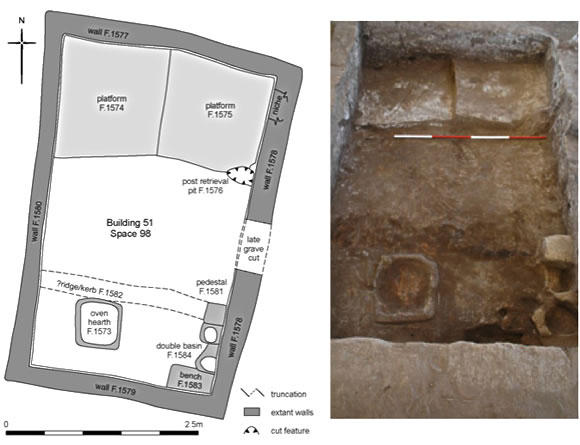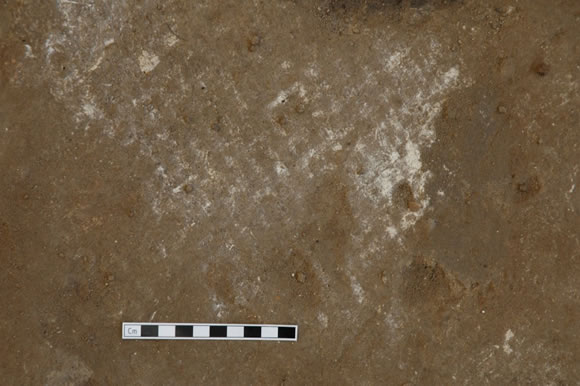ÇATALHÖYÜK 2005 ARCHIVE REPORT
| |
4040 Area Excavations
Neolithic Sequence / Neolitik Sıralama
Northern sector buildings
Up to four structures are represented in this northern sector of buildings of which Building 51 represents the latest followed by Building 52 and then structures to the west called Space 90. The construction sequence is based on the stratigraphic relationship of the buildings exposed but no dating was possible because of the paucity of finds. A tentative date of Levels VI – VII is based on the meagre dates retrieved from last years excavations.
Building 51
Abstract
Building 51 comprised a single small room Space 98. Two stepped platforms lay against the north wall with a niche cut into the east wall leading on to the NE platform and a post pit at the southern end of it. Phytolith traces of a woven mat were also clearly preserved on the surface of the NE platform. The southern area of the building functioned as the food production area with a hearth surrounded by a raised boundary. There was no oven but the hearth was set relatively close to the southern wall in the position where ovens are frequently positioned and is the likely location of the entrance ladder. Positioned in the southeastern corner were a bench, a pedestal, and a double basin.
The most important piece of information about this structure is that it appears to have been built as a replacement for Building 52, which was destroyed by fire. Building 51 was constructed within the walls of a cleared out area of the burnt building in the northeast corner. A debate within the team analyses whether the fire was deliberate or accidental.
Özet
Bina 51, küçük bir oda olan Alan 98’i içerir. İki basamaklı platformlar kuzey duvarına, kuzeydoğu platformuna doğru uzanan doğu duvarı içine kesilmiş bir niş ile güney bitimindeki bir direk çukuruna dayanmaktadır. Örülmüş bir hasırın fitolit kalıntıları kuzeydoğu platformunun yüzeyinde çok iyi bir şekilde korunmuştur.Binanın güney alanı, yükseltilmiş sınırlı bir fırını olan bir
yiyecek üretim alanı olarak kullanılmıştır.Fırının olmamasına rağmen ocak, güney duvarına yerleştirilmiş olup, fırınların genel olarak yerleştirildiği ve giriş merdiveninin yerinde bulunan bir noktadadır. Ayrıca güneydoğu köşede bir seki, kaide ve çift bir leğen bulunmaktadır.
Bu binayla ilgili en önemli bilgi, yanmış olan Bina 52’nin yerine yapılmış olmasıdır. Bina 51,yanmış binanın temizlenmiş bir alanının duvarları içinde, kuzeydoğu köşesinde inşa edilmiştir. Yangının kaza mı veya özellikle mi çıkartılmış olduğuna dair tartışma hala devam etmektedir.

Figure 30. Building 51 in plan and photograph. |
Building 51 comprised of a small room (Space 98) that was originally seen in plan during the surface scrape of 1993. The building was self-contained within one room (Figure x) constructed within the northeastern area of Building 52. After a fire destroyed Building 52 (see below), Building 51 was erected above the fire-damaged floors. This is clear because none of the walls to Building 51 were damaged in the fire despite abutting the severely fire damaged internal walls of Building 52 and the burnt floors of Building 52 extended under the wall of Building 51. The extent to which the northeastern part of Building 52 was cleared to make way for the new building is uncertain until Building 51 is fully excavated but it seems that some of the burnt brick material was partly shovelled into Space 254 which contained a concentration of burnt material in the fill at its northeastern end.
As yet there is no definite indication of how much time had elapsed after the destruction of Building 52 before Building 51 constructed but it was probably relatively short. Perhaps one reason for the construction of such a small building (4.3 x 2.7m) could be that after the fire a new building was needed quickly or that, for whatever reason, only a smaller building was required. However, it should also be mentioned that Building 49 to the east of Building 51 was also a small structure and the two appear to have been roughly contemporary. This could indicate a new practice of constructing smaller buildings although more buildings will have to be excavated to explain why these buildings were so small.
Despite the small size of Building 51 it was probably occupied for a moderate length of time allowing some 1-2cm of plaster to build up on the walls internal surface. A post was positioned along the eastern wall at the southern end of the NE platform. This may either been for structural support or allowing access into the building.
Other features of the internal arrangement of Building 51 are a NW platform (F.1574) stepping up to a NE platform (F.1575). A small semicircular niche was also located cut into the northern end of the east wall opening onto the NE platform. The NE platform had been covered in a clearly woven mat left at the abandonment of the building leaving an obvious phytolith impression on the plaster surface (10319). This weave of the matting ran diagonally across the platform covering much of its surface (Fig 31).
The southern area of the building functioned as the food production area of the building with a hearth F.1573, surrounded by a raised boundary. There was no oven but the hearth was set relatively close to the southern wall in the position where ovens are frequently positioned and is the likely location of the entrance ladder. As with the matting on the NE platform, the hearth was not completely cleaned out at the abandonment of the building. Above the hearth was a charcoal rich, ashy deposit (10317) from its last burning. A number of other features abutted the wall in the southeastern corner were a bench F.1583, a pedestal, F.1581 and a double basin F.1584.
The floor in the middle of the building was approximately 0.1m lower than the NW platform and had not been plastered. However, there does not appear to have been an extensive built up of ‘dirty’ floor layers because at the same level as the base of the hearth, traces of the underlying building (Building 52) started to become visible.
Initially F.1582 was interpreted as a destroyed partition wall but it now seems that this may be the trace of an underlying wall. At floor level in Building 51, the western part of wall F.1582 appeared to be robbed out and the eastern side showed signs of burning. This scar of a wall showing in Building 51 is therefore probably an internal wall in Building 52 (with plaster on the southern side) that was partially burnt in the fire and dug out before the construction of Building 51. After the abandonment of Building 51 it was infilled with a sterile deposit [unit]

Figure 31. Woven mat impression (10319) on NE platform F.1575 had been covered in a clearly woven mat left at the abandonment of the building leaving an obvious phytolith impression on the plaster surface (10319). This weave of the matting ran diagonally across the platform covering much of its surface. |
| |
© Çatalhöyük Research Project and individual authors, 2005